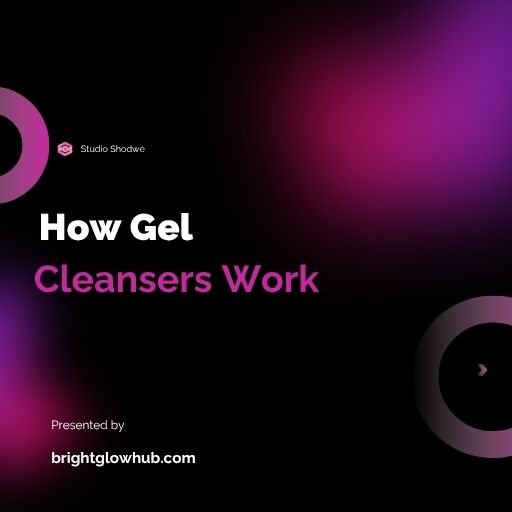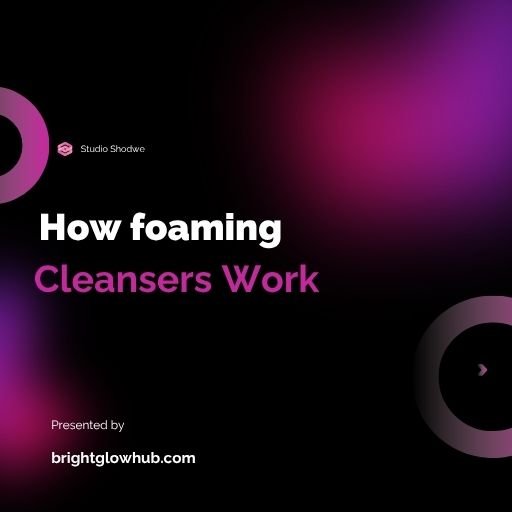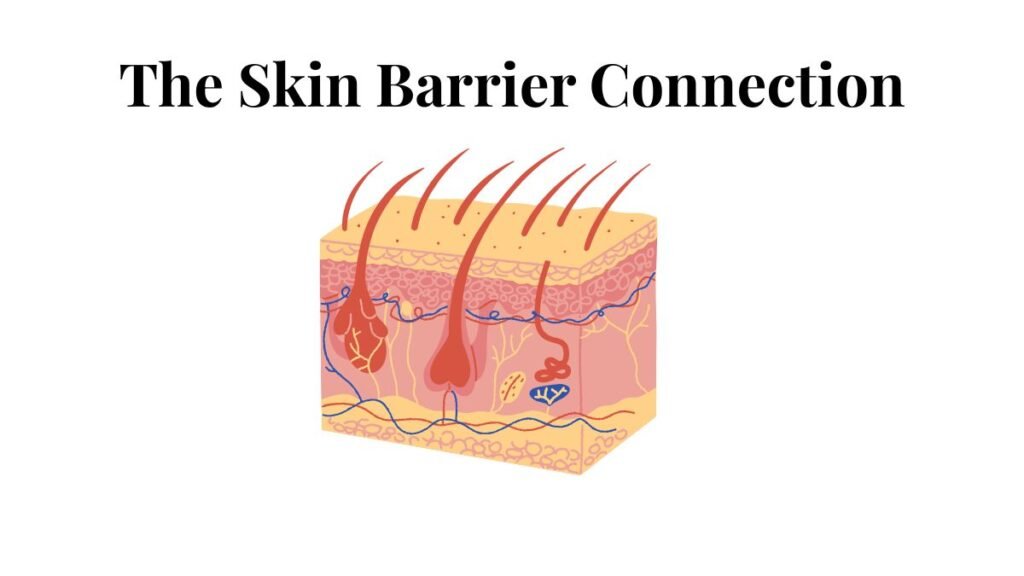Understanding how facial cleansers work is essential for anyone looking to maintain healthy, glowing skin. These skincare staples do much more than just wash away the day—they play a crucial role in removing impurities, supporting the skin barrier, and preparing the complexion for the rest of one’s routine.
⚠️ DISCLAIMER: We are not dermatologists or skincare professionals. This article provides general information about how cleanser works for educational purposes only. Individual skin types and reactions vary greatly. What works for one person may not work for another. Always patch test any new product or ingredient before full facial application. For persistent skin concerns, conditions, or allergic reactions, consult a board-certified dermatologist. This information should not replace professional medical advice.
The Science Behind Facial Cleansers
The science behind facial cleansers reveals a fascinating combination of chemistry and dermatology. At their core, these products are designed to attract both water and oil, allowing them to lift away dirt, excess sebum, and environmental pollutants that accumulate on the skin’s surface throughout the day.
How Surfactants Work in Cleansers
The magic of how surfactants work in cleansers lies in their unique molecular structure. Surfactants are compounds with two distinct ends—one that loves water (hydrophilic) and one that loves oil (lipophilic). When applied to the skin, these molecules surround dirt particles and oils, breaking them down into smaller droplets that can be easily rinsed away with water. This is the fundamental mechanism that allows cleansers to remove dirt and oil effectively without requiring harsh scrubbing.
How Cleansers Remove Dirt and Oil
Understanding how cleansers remove dirt and oil helps explain why proper cleansing is so important. Throughout the day, the skin accumulates sebum, dead skin cells, makeup, and environmental pollutants. When a cleanser is massaged onto the face, the surfactants attach to these unwanted substances and suspend them in water, making it easy to rinse them away without disrupting the skin’s natural moisture balance.
Types of Cleansers and How Cleansers Work
Different cleansing formulations work in unique ways, making it important to understand each type before choosing one.
How Gel Cleansers Work
How gel cleansers work is particularly interesting for those with combination to oily skin. These water-based formulas contain higher concentrations of surfactants, creating a light, refreshing texture that penetrates pores effectively. Gel cleansers excel at removing excess oil and are often the best cleanser for oily skin because they provide a thorough cleanse without leaving a heavy residue.

How Cream Cleansers Work
How cream cleansers work differs significantly from gel varieties. These formulas contain emollients and oils that help dissolve impurities while simultaneously providing hydration. The creamy texture makes them ideal for those wondering about the best cleanser for dry skin, as they cleanse without stripping away essential moisture. Cream cleansers are particularly effective at maintaining the skin barrier during the cleansing process.
How Foaming Cleansers Work

How foaming cleansers work involves the rapid creation of lather when the product contacts water. The foam helps distribute the cleanser evenly across the face, and the bubbles work to lift impurities from the skin’s surface. While effective at deep cleansing, some foaming formulas can be drying, which is why many brands now offer gentler versions.
How Oil Cleansers Work
How oil cleansers work operates on the principle that “like dissolves like.” Oil-based cleansers dissolve makeup contains lipophilic ingredients that attract and break down sebum, sunscreen, and makeup. This is why oil-based cleansers dissolve makeup so effectively—the oils in the cleanser bind with the oils in cosmetic products, creating a mixture that rinses away cleanly when emulsified with water.
How Micellar Water Works
How micellar water works represents a more recent innovation in skincare. Micellar water contains tiny oil molecules called micelles suspended in soft water. These micelles act like magnets for dirt and oil, capturing impurities without the need for rinsing. This makes micellar water particularly convenient for quick cleansing or for those with sensitive skin who prefer a no-rinse option.
Deep Dive: Cleansing Techniques
How Double Cleansing Works
How double cleansing works involves a two-step process that ensures thorough purification. The first cleanse, typically with an oil-based product, removes makeup, sunscreen, and excess sebum. The second cleanse, usually with a water-based cleanser, addresses sweat, dirt, and any remaining impurities. For those interested in how to double cleanse step-by-step, the process is simple: apply the oil cleanser to dry skin, massage thoroughly, rinse, then follow with a water-based cleanser.
How to Use Cleanser Properly
Knowing how to use cleanser properly maximizes its effectiveness. Start with lukewarm water to open pores slightly, then apply the cleanser using gentle, circular motions. The question of how long to wash face with cleanser often arises—most dermatologists recommend 60 seconds of gentle massage to allow the surfactants adequate time to work.
How to Cleanse Face Effectively
Understanding how to cleanse face effectively involves more than just the technique. It’s about choosing the right product, using the correct amount (usually a nickel to quarter-sized amount), and being consistent with one’s routine. The skin benefits most when cleansing is performed morning and evening, though those with very dry skin might prefer water-only cleansing in the morning.
How Cleansing Benefits Your Skin

How Skin Cleansers Clean Pores
How skin cleansers clean pores is a common concern, especially for those dealing with congestion. Cleansers work by penetrating the pore opening and dissolving the mixture of sebum and dead skin cells that can lead to blockages. Regular cleansing keeps pores clean and minimizes their appearance over time. Understanding how facial cleansers unclog pores helps explain why consistent cleansing is crucial for clear skin.
How Cleansers Keep Pores Clean
How cleansers keep pores clean extends beyond the immediate washing process. By removing the day’s accumulation of oil and debris, cleansers prevent the buildup that leads to enlarged pores and blackheads. This regular maintenance is one of the key ways that cleansers help prevent breakouts before they start.
How Cleansing Helps Your Skin
How cleansing helps your skin goes far beyond simple hygiene. Regular cleansing removes dead skin cells, allowing newer, fresher skin to surface. It also helps regulate how cleansing impacts sebum production by preventing the overproduction that can occur when pores are clogged. Additionally, understanding how cleansing helps with glowing skin reveals that a clean canvas reflects light better, creating that sought-after radiance.
How Cleansers Support Healthy Skin
How cleansers support healthy skin involves multiple mechanisms. They create an optimal environment for cell turnover, help maintain proper hydration levels when formulated correctly, and protect the skin from external aggressors. This is particularly important when considering how cleansers protect from pollution damage—by removing particulate matter and free radicals that accumulate throughout the day.
The Skin Barrier Connection

How Cleansers Maintain Skin Barrier
How cleansers maintain skin barrier function is critical for overall skin health. The skin barrier, composed of lipids and proteins, protects against moisture loss and external irritants. Gentle cleansers preserve this barrier by avoiding harsh stripping action, while how gentle cleansers protect skin becomes evident in their ability to cleanse without causing irritation or compromising the protective layer. read the complete guide What to Know About Your Skin Barrier and How to Protect It
How pH Balance in Cleansers Affects Skin
How pH balance in cleansers affects skin is an important consideration. The skin’s natural pH is slightly acidic (around 4.7-5.5), and cleansers that match this pH help maintain the skin’s protective acid mantle. Alkaline cleansers can disrupt this balance, potentially leading to dryness, sensitivity, and increased susceptibility to bacteria.
How to Cleanse Without Stripping Skin
Learning how to cleanse without stripping skin requires selecting products with moisturizing ingredients and avoiding over-cleansing. The key is finding a balance where the skin feels clean but not tight or uncomfortable. This is where understanding how to avoid dryness after cleansing becomes valuable—following up immediately with hydrating products helps lock in moisture.
Specialized Cleansing Concerns
How Cleansers Affect Acne-Prone Skin
How cleansers affect acne-prone skin depends largely on formulation. The right cleanser can be transformative, removing excess oil and bacteria that contribute to breakouts. Understanding how cleansers help prevent breakouts involves recognizing that regular cleansing reduces the buildup of comedogenic substances while maintaining a balanced skin environment that’s less hospitable to acne-causing bacteria.
How Cleansers Remove Makeup
How cleansers remove makeup effectively depends on the type of product used. Oil-based formulas excel at breaking down long-wearing and waterproof cosmetics, while micellar water offers a gentler alternative for lighter makeup. The double cleansing method combines both approaches for complete makeup removal.
How Hydrating Cleansers Work
How hydrating cleansers work involves incorporating humectants and emollients that attract and retain moisture while cleansing. These formulas are particularly beneficial for those concerned about maintaining hydration, as they deposit beneficial ingredients even as they remove impurities.
How Exfoliating Cleansers Work
How exfoliating cleansers work combines two steps into one by incorporating gentle acids or physical exfoliants into the cleansing formula. These products remove dead skin cells while cleansing, but should be used judiciously to avoid over-exfoliation. They’re particularly effective at how deep cleansing works when used appropriately.
Cleanser Ingredients and Formulations
Ingredients in Facial Cleansers
The ingredients in facial cleansers vary widely, but common components include surfactants, humectants, emollients, and active ingredients like salicylic acid or glycolic acid. Understanding these ingredients helps consumers make informed choices about which products will work best for their skin type.
How Sulfate-Free Cleansers Work
How sulfate-free cleansers work utilizes gentler surfactants derived from sources like coconut oil or sugar. While they may not foam as dramatically as traditional sulfate-containing cleansers, they’re equally effective at cleansing and tend to be less irritating for sensitive skin types.
Cleanser Selection and Usage
How to Choose the Right Cleanser
Understanding how to choose the right cleanser involves assessing one’s skin type, concerns, and lifestyle. Those with oily skin might prioritize the best cleanser for oily skin with stronger surfactants, while those with dry skin should look for the best cleanser for dry skin featuring hydrating ingredients.
How to Know If a Cleanser Suits Your Skin
How to know if a cleanser suits your skin becomes apparent within a few weeks of consistent use. The skin should feel clean but comfortable, with no tightness, redness, or increased breakouts. Any of these signs indicate the product may not be appropriate for one’s skin type.
How Often to Use Facial Cleanser
How often to use facial cleanser typically ranges from once to twice daily. Most dermatologist recommended cleansers suggest evening use at minimum to remove the day’s accumulation, with morning cleansing optional based on skin type and personal preference.
How Skin Reacts to Over-Cleansing
Understanding how skin reacts to over-cleansing is important for avoiding damage. Excessive cleansing can compromise the skin barrier, leading to dryness, sensitivity, increased oil production (as skin tries to compensate), and vulnerability to irritants and bacteria.
Cleansing and Your Skincare Routine
How Cleansers Prepare Skin for Skincare Routine
How cleansers prepare skin for skincare routine is fundamental to product efficacy. Clean skin allows serums, treatments, and moisturizers to penetrate more effectively, maximizing their benefits. This is why understanding how cleansing enhances product absorption is crucial for anyone investing in quality skincare products.
How Cleansers Support Skincare Routine
How cleansers support skincare routine extends beyond preparation. They set the stage for everything that follows, ensuring that active ingredients can work optimally without having to compete with layers of oil, dirt, and debris.
How Cleansers Interact with Moisturizers
How cleansers interact with moisturizers is an often-overlooked aspect of skincare. A cleanser that’s too harsh can make even the best moisturizer struggle to restore hydration, while a properly balanced cleanser creates the ideal environment for moisturizers to seal in hydration and beneficial ingredients.
Water-Based vs. Oil-Based Cleansing
How Water-Based Cleansers Purify Skin
How water-based cleansers purify skin relies on their ability to mix with water and rinse away cleanly. These formulas are excellent for removing water-soluble impurities like sweat and water-based products, making them a staple second step in double cleansing routines.
How Impurities Are Removed by Cleansers
Understanding how impurities are removed by cleansers reveals the elegance of surfactant chemistry. Whether water-based or oil-based, cleansers work by surrounding impurities and allowing them to be washed away, rather than simply pushing them around on the skin’s surface.
Additional Benefits of Regular Cleansing
Benefits of Cleansing Face Daily
The benefits of cleansing face daily accumulate over time. Regular removal of impurities prevents buildup, supports cell turnover, and maintains skin clarity. Daily cleansing also helps regulate oil production and keeps the complexion looking fresh and healthy.
How Cleansers Remove Dead Skin Cells
How cleansers remove dead skin cells happens through gentle mechanical action and, in some formulas, chemical exfoliation. Even without specific exfoliating ingredients, the act of massaging a cleanser across the skin helps dislodge dead cells that are ready to shed, revealing the fresher skin beneath.
Cleanser Categories Compared
Difference Between Cleanser and Face Wash
The difference between cleanser and face wash is often semantic, though some use “cleanser” for cream-based products and “face wash” for gel or foaming formulas. Functionally, both serve the same purpose of removing impurities, with the distinction being more about marketing and texture than efficacy.
Frequently Asked Questions:
What’s the difference between cleanser and face wash?
The difference between cleanser and face wash is largely a matter of terminology and texture. Generally, “cleanser” refers to cream or lotion-based formulas, while “face wash” often describes gel or foaming products. However, both serve the same fundamental purpose of removing impurities from the skin. The choice between them should be based on skin type and personal preference rather than the label.
How long should you wash your face with cleanser?
The ideal answer to how long to wash face with cleanser is approximately 60 seconds. This gives the surfactants enough time to break down oils, makeup, and impurities effectively. Spending less time may not thoroughly cleanse the skin, while excessive scrubbing can cause irritation and compromise the skin barrier.
How often should you use facial cleanser?
How often to use facial cleanser depends on skin type and lifestyle. Most dermatologist recommended cleansers suggest cleansing twice daily—once in the morning and once before bed. However, those with very dry or sensitive skin might benefit from cleansing only once per day in the evening and using just water in the morning.
What should people with dry skin look for in a cleanser?
The best cleanser for dry skin should contain hydrating ingredients like glycerin, ceramides, or hyaluronic acid. Cream cleansers are often ideal because of how cream cleansers work—they cleanse while depositing moisturizing ingredients. Those with dry skin should also focus on how to avoid dryness after cleansing by immediately applying moisturizer to damp skin.
How do you know if a cleanser is working for your skin?
Understanding how to know if a cleanser suits your skin involves observing how the skin feels and looks after a few weeks of use. A good cleanser should leave skin feeling clean but not tight or uncomfortable. There should be no increased redness, irritation, or breakouts. The skin should appear balanced and healthy.
Can cleansers help with acne?
Yes, understanding how cleansers affect acne-prone skin shows that the right cleanser can make a significant difference. Cleansers help prevent breakouts by removing excess oil, dead skin cells, and bacteria that contribute to acne. However, they should be gentle enough to avoid irritating the skin, which can worsen breakouts.
Conclusion
Understanding how facial cleansers work empowers individuals to make better skincare choices and develop routines that truly serve their skin’s needs. From the molecular action of surfactants to the practical application of double cleansing, each aspect of cleansing plays a role in maintaining healthy, radiant skin. By selecting the appropriate cleanser type and using it correctly, anyone can harness the full benefits of this fundamental skincare step.
Whether one prefers gel, cream, oil, or micellar formulas, the key is consistency and choosing products that respect the skin barrier while effectively removing impurities. With this knowledge, achieving clean, balanced, and healthy skin becomes not just possible, but sustainable.
